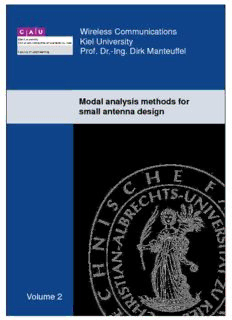
Modal analysis methods for small antenna design PDF
Preview Modal analysis methods for small antenna design
Wireless Communications Kiel University Prof. Dr.-Ing. Dirk Manteuffel Modal analysis methods for small antenna design Eugen Safin Volume 2 1. Gutachter Prof. Dr.-Ing. Dirk Manteuffel 2. Gutachter Prof. Dr.-Ing. Pavel Hazdra 3. Gutachter Prof. Dr.-Ing. Gerhard Schmidt 4. Gutachter Prof. Dr.-Ing. Ludger Klinkenbusch 5. Gutachter Prof. Dr.-Ing. Michael Höft Datum der mündlichen Prüfung: 15.12.2016 Modal analysis methods for small antenna design Dissertation zur Erlangung des akademischen Grades Doktor der Ingenieurwissenschaften (Dr.-Ing.) der Technischen Fakultät der Christian Albrechts-Universität zu Kiel Eugen Safin Kiel 17.03.2016 Hiermit versichere ich, dass ich die Doktorarbeit Modal Analysis Methods for Small Antenna Design selbständig und ohne unzulässige fremde Hilfe angefertigt habe und dass ich alle von anderen Autoren wörtlich übernommenen Stellen, wie auch die sich an die Gedankengänge anderer Autoren eng anlehnenden Ausführungen mei- ner Arbeit, besonders gekennzeichnet und die entsprechenden Quellen ange- geben habe. Weiterhin wurde die Arbeit ausschließlich der Christian-Alb- rechts-Universität zu Kiel im Rahmen eines Prüfungsverfahrens vorgelegt, je- doch wurden Teile in Form von Beiträgen in Fachzeitschriften und Tagungs- bänden veröffentlicht bzw. zur Veröffentlichung eingereicht (siehe Abschnitt zu Publikationen). Diese Arbeit ist unter Einhaltung der Regeln guter wissen- schaftlicher Praxis der Deutschen Forschungsgemeinschaft entstanden. Eugen Safin Abstract The Theory of Characteristic Modes (TCM) has proved itself well in antenna design even in the recent years. A large number of applications has been pre- sented by other authors, in which the TCM has been utilized. In this disserta- tion, the common theory is extended with new numerical techniques suitable for the design of small antennas. Eigenvalue tracking as a fundamental numer- ical problem, which arises from the early mode analysis, is discussed. The de- generated mode effect is presented and an explanation is given as to where it comes from and how it affects the tracking concept. A new algorithm is pre- sented to generate differential eigenvalue curves and to compensate for the de- generated mode effect. The modal source reconstruction is an additional technique, which is used to predict the mode contribution from a simplified structure. This technique al- lows utilization of the TCM with other not Method of Moments based solver under the assumption that the simplified structures carries almost the same chassis modes as the real structure. Furthermore, the lumped impedance matching networks are treated in the mode analysis. The influence of such lumped networks on the characteristic modes is investigated and the modal efficiency is defined. The definition of the modal admittances and impedances are given and evaluated for inductive and capacitive coupling elements. Equiv- alent circuit models are presented and evaluated for these types of coupling elements for generic examples. The problem of a useful interpretation of the dielectric modes and their eigen- value are discussed and evaluated for dielectric resonator antennas (DRAs). Conditions are given where the eigenvalue of the dielectric modes determines the natural resonance of modes. A cylindrical DRA is used to validate the pro- posed interpretation of modes. Finally, the combined mode excitation concept is presented and evaluated for small terminals. This concept is used as a basis to integrate antennas into a hand held device. The experiences are used to de- velop the proposed concept further and to integrate the antennas into the rear- view mirror of a vehicle.
Description: